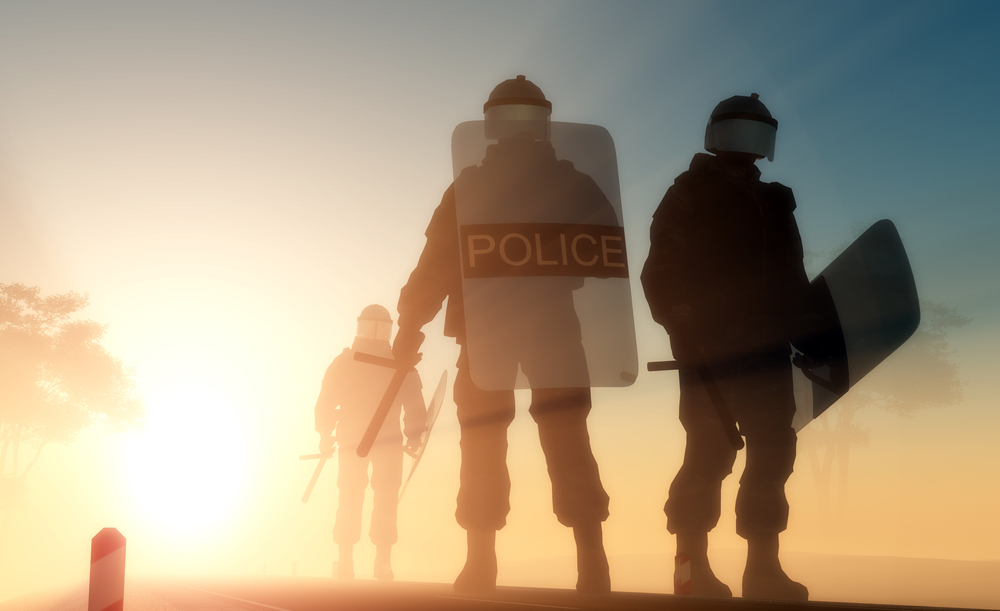
The Andy Griffith Show is one of the most beloved television series of its time and is considered one of the greatest shows of all time. In the show, small-town Sheriff Andy Griffith and his deputy Barney Fife keep the peace in the town of Mayberry, NC. Sheriff Griffith is an excellent archetype for what law enforcement officers in America used to be. Today, this notion of the small-town “peace officer” is almost unrecognizable. Replaced with the so-called “warrior-cop,” American police officers have become increasingly armed with military training, equipment, and weapons, ranging from armored cars to small arms and body armor.

The militarization of police is a hotly debated topic. Many in favor of militarization claim that giving police military-style equipment will save officers’ lives. One site writes, “Armor saves lives, and the better the armor, the more good-guy lives can be saved.” What this statement doesn’t address is how using military equipment, such as body armor and armored vehicles, affects police officers’ risk assessment and decision-making.
In his 1975 paper, Sam Peltzman described the effects of automobile safety regulation. Rather than just saving drivers’ lives, the seen effect of automobile safety policy, an unseen effect exists in the form of reckless driving and pedestrian deaths. The logic is as follows: drivers forced to wear seatbelts engage in more risky behavior since they believe they are safer. This behavior offsets the lives saved by wearing a seatbelt, causing pedestrians to be killed by reckless, seatbelt-wearing drivers.
Peltzman’s insights on safety regulation can also be applied to the police. Police officers who use devices that give them fire superiority or increase their safety (whether body armor, automatic rifles, or armored cars) have lowered the marginal cost of escalating situations and using violence. For example, a law enforcement officer not wearing body armor is much less likely to draw his weapon on a civilian since he knows a gunshot to the torso may be fatal. The officer who wears body armor has less of an incentive to avoid physical conflict since he believes wearing body armor makes him safer. This, too, applies to police using armored vehicles and small arms.
The 1033 Program was officially started in 1997 but had a predecessor in the National Defense Authorization Act, created in 1990. The program allows the Department of Defense to provide military hardware to law enforcement agencies. Between 1997-2014, over 5 billion dollars of military equipment (new and used) was transferred from the Department of Defense to American local law enforcement agencies. These transfers included everything from military armored vehicles and ammunition to small arms and body armor.
According to the Law Enforcement Epidemiology Project at the University of Illinois at Chicago, civilians killed by law enforcement increased from roughly 400 deaths in 1999 to nearly 800 deaths in 2020 (even before the high crime year of 2020, civilian deaths were greater than 600 per-year between 2017-2019). In addition to civilian killings by police, there are other horrific consequences of militarized police, including a horrifying incident where a SWAT team threw a flashbang into a baby’s playpen, exploding near the child’s face. Additionally, according to a paper published by the Proceedings of the National Academy of Sciences, “using nationwide panel data on local police militarization, I demonstrate that militarized policing fails to enhance officer safety or reduce local crime.” While undoubtedly additional factors have led to an increased number of citizens killed by police, risk compensation due to police militarization is most certainly a factor leading to the rise in citizen deaths. Moreover, the perceived benefit of increased safety to officers from military-style equipment may also lead to more police deaths.
Given that police use of armored cars and other military equipment has nasty, unseen consequences, how could it stop? One solution would be to end the Federal subsidization of local police departments through the 1033 Program, giving citizens more control over how militarized their law enforcement agencies are. Ultimately, it is important to remember Bastiat’s words, “Your theory has stopped at what is seen and takes no account of what is not seen.” In our case, we must understand that risk compensation may often have negative consequences when considering law enforcement policy.
Samuel Peterson is a student at Grove City College majoring in economics. He is a summer Research Intern at the Competitive Enterprise Institute and an inaugural Mises Institute Apprentice.

READER COMMENTS
Thomas Hutcheson
Jul 9 2023 at 1:40pm
Like all policy interventions one has to “solve for the equilibrium” as Tyler Cowen likes to say, that is the cost benefit analysis of the policy had to be done correctly lest the net benefit is negative. But the full analysis has to be done; noting that there ARE costs does not count. 🙂
Matthias
Jul 9 2023 at 9:05pm
Btw, this risk compensation effect isn’t necessarily a bad thing.
For example, seat belts and airbags allow drivers to move faster from A to B while keeping the same preferred risk profile. (At least of risk to themselves. Pedestrians are hit by an externality.)
Compare the introduction of seatbelts to a hypothetical ban on brakes. Driver fatalities would probably stay similar, but people would drive much, much slower.
Dylan
Jul 10 2023 at 10:25am
The way I (used to) drive a boat, begs to differ!
Comments are closed.